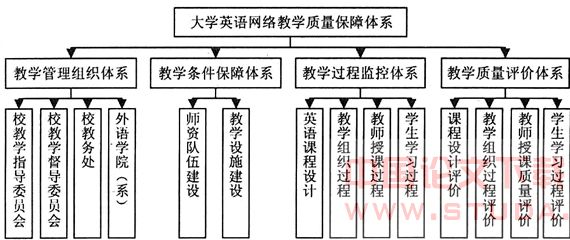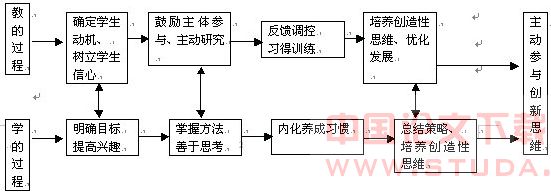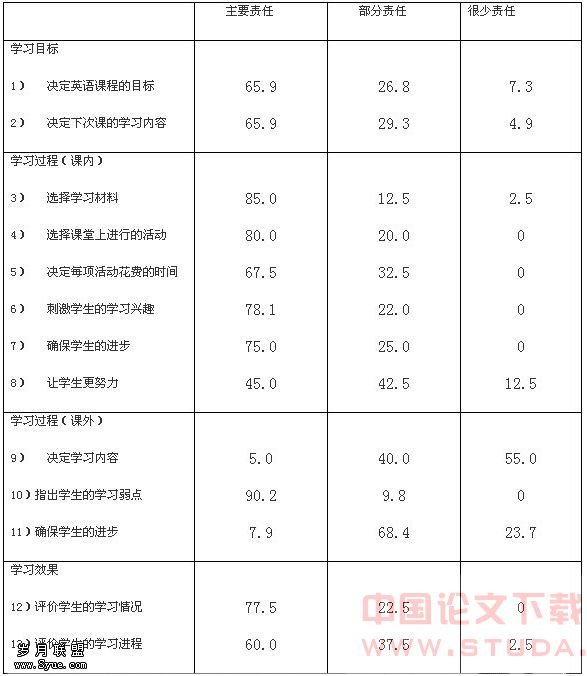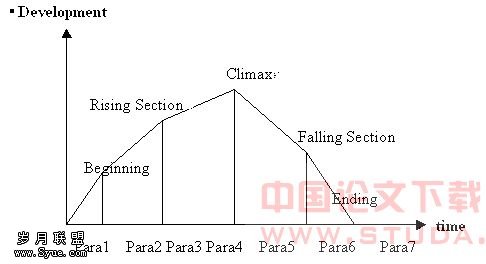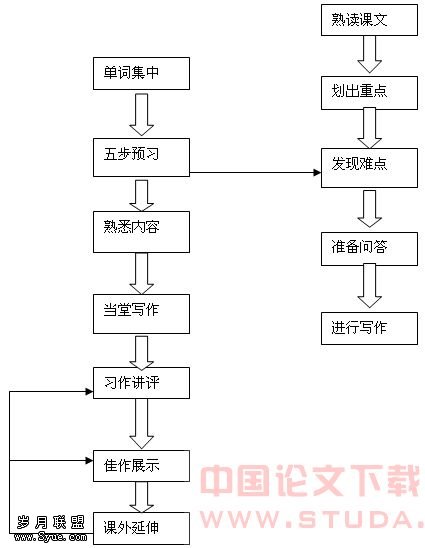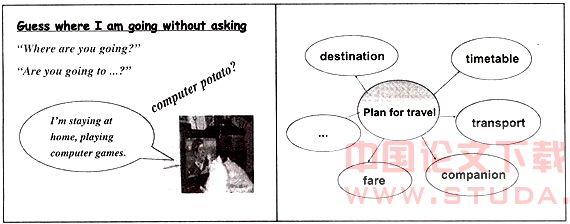中国中学生英语口语焦虑问题的教学策略
[Abstract] Currently, students learning English have realized the importance of oral English and they are eager to acquire English speaking ability to cope with everyday communication. However, they frequently worry about their oral English when communicating with others. In this article, we study some difficulties in learning oral English of middle school students by doing informal surveys on them. According to the surveys, they encounter many difficulties but the basic one is anxiety, which negatively affects the performances in their English speaking activities. Besides, this paper explores some practical oral English teaching strategies by studying the new teaching concepts promoted by The English Course Standards in the hope that students reduce their anxieties and are encouraged to participate in oral English communication.
[Key Words] speaking; teaching strategy; anxiety; culture sense; cooperative learning; formative assessment
[摘 要] 现今,学习者已经充分认识到英语口语的重要性,因此渴望能够掌握用英语流利交流的口语技巧。但是,进行交流的时候,学生往往因为顾虑重重而没有办法自由地表达其所思所想。本文通过对一些学生做出的非正式的调查了解到学生在英语口语过程中遇到的难题。学生学习英语口语过程中遇到的难题很多,但是其中最普遍的是学习讲英语时候的焦虑感和紧张感。焦虑和紧张成了学生开口讲英语的思想障碍,对学生英语学习百害而无一利。本文还对新课程标准所提倡的一些口语教学理念及口语教学评价理念做出可行性分析并对可行性较强的英语口语教学策略做出初步探讨,力图减少学生讲英语过程中的焦虑感和紧张感,使学生能够用英语自由地表达思想,真正把英语作为一种使用的交流工具。
[关键词] 英语口语;教学策略;焦虑感;文化意识;合作性学习;形成性评价
1. Introduction
English speaking is a demonstration of a person’s overall ability to use English. It is the skill that is judged upon most in real-life situations. It is also an important part of everyday interaction and most often, the first impression of a person is based on his/her ability to speak fluently and comprehensibly. In many other countries, oral English is a basic skill for students to master, and therefore they paid a lot attention to English speaking at schools.
On January 3rd, 2004, the Ministry of Education issued a notice concerning the distribution of Teaching Requirements for English Curriculum. In the requirements, one shift is highlighted, namely, the shift of the focus of the teaching syllabus from reading to speaking and ing. The skill of speaking has also been required in the new English Syllabus and The Senior English Course Standards published by the Education Ministry of China has regulated English Speaking as one of the compulsory course.
But the current Chinese education, to a great extent, has been carried out in a sort of “fixed” system of “grammar and vocabulary only”, and oral courses are almost nowhere to be found. So, the problem of students is not having nothing to say but not knowing how to say. Just as Huchun Dong says, students say what they can say but not what they want to say. [1] This doubtlessly limited the opportunities of students’ individual development.
It is not easy to teach English and it is more difficult to teach oral English. In order to develop students’ oral competence so that they can use the language they have learned correctly, appropriately and expressively in real situations, the teacher needs to be acquainted with as many teaching strategies as possible, and understand the underlying theories and principles, so that he/she not only knows what to teach and how to do it, but also why he/she could do it in a certain way and how to solve problems when they arise.[2]
2. Some difficulties in learning oral English of middle school students
English learning is a complex process, subject to the influence of social, linguistic, educational, and cognitive factors. [3] It is reasonable that students worry about their disfluency and unidiomaticity and other aspects of language use. Recent talks with a group of students learning English that I interviewed informally after oral classes prove that the following are among their difficulties: Lack of interest in learning English makes it impossible for students to speak with the instructor and peers actively in the ESL classroom; Anxieties relating to English speaking negatively affect performance in English speaking; Inappropriate and unfair assessments making by teachers make students hesitate to speak.
When teaching in Xiang’an No.1 Middle School, Xiamen, as a practice teacher in March, 2006, we did an informal survey on the situation of students’ learning of oral English. The questionnaire was designed to get a rough idea of the oral English learning of the students and particularly the difficulties students meet in speaking English (see appendix.)[4].
According to the analysis (see appendix), 54.3% of the students find it difficult to speak well because they are afraid of criticism or losing face. Anxieties get in the students’ way to speak; 51.2% of the students like the section of free talk; 82.1% of the students realize that the ability to speak English fluently is very important; 94 % of them are interested in foreign culture and customs; nearly half of the students wish that their teacher can correct the mistakes they make with encouragement and smile and they wish to be assessed in various ways.
Students learning English frequently worry about the small-size vocabulary, incorrect grammar and inappropriate expressions in their spoken English when communicating with others. English teachers are very familiar with the worries that English learners feel in their language learning process, particularly in their oral communication. This worry phenomenon should be included in anxiety in SLA research.[5] In reviewing research examining the effects of anxiety on language learning, Macintyre and Gardner concluded that learners’ excessive anxiety “negatively affects performance in the second language”. Worrying too much about learning and performance is both unnecessary and harmful. It may prevent learners from practicing English-speaking skills.[6]
3. Related teaching strategies
3.1 Developing students’ culture sense
3.1.1 Analysis and strategies
If the students’ motivation for learning English is zero, teaching them speaking English will be a huge problem for the teacher. So, before deciding on any other teaching strategies, what the teacher has to do is to arouse students’ interest and increase their motivation in learning English. There are many techniques that a teacher can take to help motivate students’ interest to learn, but no one motivational technique works well for all students. Since 94% of the students attending the questionnaire wish that their teacher could introduce foreign culture as often as possible, one can safely conclude that developing students’ culture sense is a general motivation practice which can motivate their interest in English.
The culture-bound aspect of teaching material is often of great interest to students, and it can be used to provoke an interesting discussion not only about the “other” culture, but also about the “home”culture. The discussion results may facilitate the speaking tasks.
Once students’ interest is motivated, they will realize that learning English has a lot of fun and will surely enjoy learning English. Once they enjoy learning English, they may look forward to speaking English and they are less likely to be afraid of speaking. So, provoking students’ interest can be considered as a good way to ease students’ anxieties in speaking.[7]
Another reason for developing students’ culture is that language is the carrier of culture and the importance of teaching culture is emphasized in the The English Course Standards. To accord with the course standards, culture teaching is supposed to be an important part in a successful teaching plan. While teaching oral English, getting the students familiarized with the culture and social background relevant to the speaking task is essential.
One problem in communicating with foreigners is that many words and expressions spoken by the foreigners are culture-bound and students cannot bring their knowledge of the world to help them understand the conversation.
Take the word “privacy” for example. Individuality is regarded as a characteristic of the western culture and privacy is a common sense of the westerners. So, “privacy” has two meanings in the dictionary (Oxford Advanced Learner’s English-Chinese Dictionar, 4thedition): one is “state of being away from others, alone and undisturbed”; the other is “secrecy, opposite to publicity”. However, in China, where people do not care about their privacy that much, “privacy” refers to “secret” only. When they talk about “privacy”, they are often referring to egotism and secrets of love affairs. While in the western countries, people respect others’ privacy and “mind your own business” is an important code in the social etiquettes.[8]
Besides, different conventions lead to different usages of language and difficulties in communication. Daily compliments, salutations, thanks, regrets, comity and taboo are culture-bound. For example, when the Chinese are not to accept their friends’ invitation, they use some tactful expressions “may be I will come” “I will think of it” instead of the negative word “no”. Because we do not think saying “no” to our friend is a polite way to refuse. They choose to make promises rather than refusal in order not to harm the relationships. However, for a westerner, such kind of behavior means breaking one’s promise and they will be angry at the Chinese. Not knowing such kinds of culture differences, one will never make a good communication.[9]
So the teacher should bear an open attitude towards foreign culture, share with students what he/she knows about how foreign culture differs from his/her own, and present them in teaching. To get students familiar with Western culture, a teacher may create some situational contexts or employ role-play games for the students to experience this culture and know the differences in comparison with their own.
3.1.2 Operation and practices
One practical way to teach culture is to create an authentic classroom environment. Classroom decorations and displays of all kinds, posters, cartoons, maps, newspaper cuttings, and exhibitions of trifles, such as theatre tickers and programmers, bus and train tickets, railway and airline timetables, restaurant menus, and so on create a visual and tangible presence of the target community. This is particularly important in a foreign language setting where the reality of language use in the speech community is geographically and psychologically far removed from the classroom.
Playing an episode of a foreign movie to introduce students an aspect of way-of-life culture is also a good way to provide situational contexts. For example, if a teacher wants to introduce the western dinner etiquette, he/she can tell the students that the French spoon toward themselves and eat from the end of the spoon, not the side; While eating, it is proper to keep your free hand on the table, not in your lap; Also, the bread is quite handily used to scoop up vegetables or sauces and clean up the plate at the end of the meal; To cut food, the knife is used in the right hand and the fork in the left; Food is then put directly in the mouth with the left hand and the fork. The knife is held in the right hand while chewing; When whole fruits (such as apples or pears) are served, they are not eaten with the hands. The fork is again used in the left to hold the fruit and the knife is used to cut and peel the fruit. The pieces of fruit are then eaten with the fork in the left hand. It is important that the plate be empty at the end of the meal…
After these introductions, the teacher may well practice his/her oral English but not the students. And students are likely to be confused by such long and complex soliloquy. Instead, the teacher can introduce this culture by playing the movie “Pretty Woman”, in which there is scene that the actress Vivian asks a restaurant manager to teach her how to behave at the dinner table. Instead of the long and confused introduction, the video demonstrates students the correct way to eat bread or soup, and how to cut up and eat fruit, meat and vegetables in several minutes.
The teacher can practice students’ oral English while introducing the culture. After watching the video, the teacher can provide students some questions to discuss: Is the described behavior generally applicable in a French home environment, or does it reflect only the customs of an urban middle class family? Is it a useful guide to the type of behavior expected of a foreigner? For a traveler or worker living in the host community is it important to know what aspects of behavior are tolerated from a foreigner and which would be regarded as embarrassing, unacceptable, or even rude and ludicrous? By discussing such kind of interesting questions, students learn both foreign culture and oral English.
3.2 Promoting cooperative learning
3.2.1 Analysis and strategies
Cooperative learning is a successful strategy promoted in the course standards, in which students work together to understand and improve their learning. Cooperative learning advocates teaching speaking through interactive tasks and in practical terms, this leads to the use of pair –work and group work activities.
Cooperative learning often creates student-centered climate in classroom. Students in such classroom will feel more relaxed and easy to perform, either learning or speaking. Many students are afraid of speaking in front of a whole class because they are worrying about criticism and losing face or they simply feel shy. So, if the speaking tasks are designed to be completed in small group, this anxiety is less likely to happen.
Besides, speaking in small groups is more natural, because in real life, students spend most of their time talking to one other person or to a few other people. If theyt speak to a large group of people, it is usually a more formal situation where they have spent time preparing what they are going to say.[10] Cook and Nicholson point out that small group work helps students learn to work cooperatively and it helps them develop interpersonal skills. When students work with other students who are not their friends, they learn how to work with a wider variety of people and this fosters development of tolerance, mutual respect and harmony.[11] If students cooperate in harmony and with joy, anxiety will surely be forgotten.
The second characteristic of a successful speaking task is that students talk a lot in the foreign language. This is the strongest argument for using small group work because it increases the time for each student to practice speaking in one lesson. The only way to become good at a skill is to practice it. Nobody expects to be good at playing ping pong the first time they try even if they already know all the rules very well and have watched others play many times. The same is true of speaking a foreign language. [12] It is self-evident that the more opportunities students get to practice speaking, the less anxieties they feel.
If the weak students are asked to work with more advanced students, they may be also pressed with anxiety. So, the last reason for using group work is that different small groups can work at different levels if the teacher groups them according to language proficiency level. It is inevitable that some students in a class will be more advanced than other students. If the teacher modifies a given task to make it easier for slower students and more challenging for more advanced students, then all students will continue learning and remain more motivated.[13]
We can use Hammer’s words to conclude the reasons for adopting cooperative learning, “Pair work and group work allows students to use language and also encourage students’ cooperation which is itself important for the atmosphere of the class and for the motivation it gives to learning with others.[siv]”[14]
When teachers organize group work, they should try to make oral English class activities task-oriented and student-centered and they should focus their attention on how to encourage the students to speak more often and more fluently. Moreover, it is necessary to change the activities of pair works or group activities so that the students do not get bored. Sometimes, a drama, a game, or simply an English song may cheer up the students and make them work more efficiently.
3.2.2 Operation and practices
Mr. Su , who is an experienced and outstanding teacher modeled a lesson using language games. The following was his presentation:
His students had learned the present perfect tense. He wanted them to use the particular rule for communicative purpose. He told the students that they were going to find people “ who have/has done” the following things:
1. studied under Professor X;
2. stocked books in a university library;
3. visited Hong Kong;
4. thrown a shoe out of a window;
[………………………………….]
The procedure went like this:
1. He prepared handout before class.
2. He grouped the students.
3. He asked each group to move around the classroom and find one person who had done each of these things. Students could only mention one persons’ name once so they would have to find different people to answer the question.
4. Students moved around and asked questions using “Have you been/done …?”
5. group members got together to collect information they get.
6. He got group leader to report their findings. They would use “So and so has/have done …
This approach advocates teaching speaking through interactive tasks. It was different from other group activities Mr. Su organized and the students who were excited by the novel activities finished the tasks more actively and effectively than ever before.
Mini-drama, like the language game, was promoted by Mr. Su. It consists of scenes of everyday life problem situations. The scene is viewed on a video. Actions are interrupted and discussed by the teacher and the students. Mr. Su said that Mini-dramas were designed not only to present a problem situation but also to involve students emotionally by discussing one or another character in the episode. The following is a scene viewed on the video by Mr. Su together with his students:
In a street market in Cannes, two young Americans, Cindy and Debbie, decide to buy peaches from a street vendor, and start picking out the peaches they want to buy.thus In the street market the vendor picks out the fruit and she does not like to be interfered and thus the two young Americans have offended the convention of the people in Cannes.
Vendor: (sarcastically) Eh, you’re planning to buy the whole tableful?
Debbie: (whispers to Cindy) Is she ever rude! I wonder what her problem is! Probably had a fight with her husband this morning.
At this point the scene is interrupted for a group discussion.
Climate in Mr. Su’s classroom is always full of joy and excitement. The secret is that he keeps it in mind to adjust the many ways of cooperative learning to different situation and different educational purposes.
3.3 Using formative assessment
3.3.1 Analysis and strategies
The form of assessment and evaluation has great backwash effects on foreign language teaching and learning. Whether to use summative assessment or formative assessment or a combination of both, will has great bearings on teachers and students.[15]
Formative assessment is an assessment causing less anxiety and it is preferred by students.
Nearly half of the students answering the questionnaire wish that their teacher could correct the mistakes they make with encouragement and smile and they wish to be assessed in various ways. They in fact prefer formative assessment.
The main feature of formative assessment is that it implies evaluation based on a collection of information about what students know and can do. This involves many ways and methods of information gathering, formal and informal, at different times and in different contexts.[16]
Another kind of assessment is summative assessment. Its main feature is that it uses tests and final examinations to make assessments. Summative assessment is a traditional assessment and it is always associated with testing, so speaking of assessment methods, many teachers immediately think of tests.
Formative assessment is promoted in the course standards to make an important difference between assessment and testing. Formative assessment is usually based on information collected about the learner’ current situation. Testing is only one of the different ways to collect information.[17] Formative assessment is to find out what the students already know and can do rather than what they do not know and cannot do, while summative assessment is to find out students’ weakness.
Crashen and Terrell who believe that anxiety has great influences on speaking, said that summative assessment is not a proper assessment and it will undoubtly increase anxiety in English study.[18] [19] Gardner, the famous psychologist, said that assessment with only tests or examinations was often conducted to find out the students’ weaknesses and it damaged the students’ motivation and confidence in language learning. Theory of Multiple Intelligence advanced by Gardner believes that assessment must be done in many ways. [20] Varying assessment methods according to assessment purposes and contexts helps to make assessment fairer and more reliable.[21] [22]
So, compared to summative assessment, formative assessment makes students feel more comfortable and motivated. Formative assessment is an assessment causing less anxiety.
Formative assessment implies many ways and methods to evaluate students. The most practical ways of formative assessment in oral English teaching are teacher’s assessment, peer assessment and self-assessment.
3.3.2 Operation and practices
(i) Teacher’s assessment
Research shows that the teacher’s knowledge of children and their strengths and weaknesses is more accurate and sound than testing. Very often the teacher’s subjective estimate of the learner’s overall performance or achievement can be quite accurate and fair [siv]. [23]
To help students speak accurately, it's important for the teacher to correct students' errors. However, it is not acceptable to make corrections when they are speaking. It's suggested that the teacher take notes of errors students make in class. If they are common problems, he/she can present them as language points and ask the students to do some practice; if they are mistakes committed by individual student, just point them out at the completion of the individual performance or give the student a note with the corrections.[24]
Another thing a teacher should deal with carefully is the comments teachers make. They should be more positive and less negative. Students need more suggestions and encouragement, less blame and experiences of failure. Teachers may write the comments and suggestions like this:
Lin Feng:
You could make your talk closely related to the topic, and tried to use what you had learnt to talk about the picture. You could also act in an appropriate manner while talking. That means you could understand the requirement of the task and be good at interacting with your audience.
Unluckily, you made some mistakes that influenced your accuracy and fluency. So you need more speaking practice, including pronunciation and intonation. I am sure you can do the work much better next time.
A teacher, who is an experienced teacher modeled a good example of teacher assessment. Students in her class had just learnt some of the body words. In order to check whether students could understand them by ing, she asked them to response what they heard with physical performances. That is, when she said “Touch your nose”, the students gave the response by touching his/her nose. In this way, she observed who could or could not do it. She said that if all of the children could follow, it gave her a signal that she could move on her teaching. Otherwise, she should do something to improve that.
Students in her class were assessed by using physical performance responses and visual tools before they can speak confidently. This type of response can reduce children's anxiety normally linked to assessment and may help children see it as a daily learning activities.
(ii) Peer assessment
Peer Assessment as well as self-assessment is popular nowadays because they can help students to develop their ownership and responsibility for their learning and thus lessen anxiety in learning. Moreover, they can enhance interaction and collaboration among students and enable them to understand each other.
Peer assessment is always used to assess role play. Role play is an informal assessment technique combining oral performance and physical activities. It makes students feel comfortable and motivated easily, especially when the activity needs group work, i.e. cooperative learning. It seems to be a funny way of learning. Role-play can be an enjoyable way of informal assessment that could be used effectively in oral English learning. In practice, students need to know the criteria beforehand and they also need to observe their partners' performance while assessing. This may easily increase, in fact, students’ involvement and promote them to do it better than others so that they will not fall behind their partners.
We can design the checking lists like this:
Performance Task:
Students use role play cards to play the roles of shop assistant and customer.
Assessment task:
Students assess their partners or their classmates on how well they can carry out the role play
by putting a tick in a column.
Table1 Role play with peer assessment
Name: Role:
Criteria Able to Partly able to Not yet able to
1.Understand task instructions given in English
2.Speak with fluency and confidence
3.Use appropriate intonation, rhythm and stress
4.Use an appropriate group of vocabulary and phrases
5.Interact in a polite and friendly manner
For peer assessment, teachers can also design anecdotal records and students themselves fill assessments in the records. Students can be grouped according to their language proficiency level and personal characters. The group leaders are supposed to make a record of the speaking activities. Checking lists may be designed as follows:
Table2 Anecdotal Records
Name Duty Report(10points) Acting ofDialogues (10points) Questions answering/rising questions(10points) Sense of Cooperati-on(10points) Process in communication(10points)
(iii) Self-assessment
The students themselves are given the chance to evaluate their own performance, using clear criteria and weighting systems agreed on beforehand.
Imitating and recall are among the most effective approaches of oral English training. When doing the pronunciation and intonation, teachers can ask students to read after the tape and record their own voice. And the students are required to hand in their record and their self-assessment on their record. By adopting this method, students are likely to form the ability of self-study and build within themselves confidence. [25]
Writing Journals is a form of self-assessment causing less anxiety, an opportunity for students to think about their knowledge of the subject and to strengthen their confidence. The journals are not graded; they offered an opportunity for dialogue between each student and the teacher.
Mr. Su asks his students to keep journals about their encounters with English in or out of class. These include insights or puzzlements. Students in his class are encouraged to express themselves in writing. Although he does not grade the students' journals, he does correct grammar and spelling, and comments on the contents with questions, references and appropriate praise. So, the exercise of writing encourages further discussion among students and between students and him. Students express themselves freely via journal and they feel that they are having a conversation with Mr. Su. Mr. Su said that students who keep journals in his class speak with more confidence and ideas than those who do not keep journals.
4. Conclusion
From this article, it is obvious that appropriate oral English teaching strategies can be considered as an effective approach to accelerate the development of students’ speaking competence, to increase their learning motivation and ease their anxieties. Language teachers are supposed to evaluate whether effective oral English teaching strategies are being overlooked or not. Moreover, these teaching strategies should be fully integrated into classroom contexts and everyday learning. Only when language teachers know how to make good use of teaching strategies in both the ESL classroom environment and everyday life can they improve their students’ speaking competence and motivation.
Apart from the strategies concerning students’ anxieties discussed in this paper, language teachers should also have patience, confidence, imagination, enthusiasm, humor and creativity. They should be friendly, sympathetic, on good terms with the students, and have an affirmative attitude towards the students and occasionally encourage them if necessary.
References
[1] 胡怡亭.培养学生即兴表达能力的尝试[J].中学外语教与学,2004, 1, p52
[2] 陈坚林.外语教学研究[M].上海:上海外语出版社, 2004, p10
[3] Zhang Wenzhong. Oral Communication Anxieties: Some concepts reconsidered [J]. Teaching English in China, 2001, 2, p11
[4] 同[2] p79-91
[5] 同[3] P9
[6] 同[3] P11
[7] 朱容影.高中生口语能力的分析与教学对策[J].中学外语教与学, 2004, 12,p49
[8] 同[7] P49
[9] 同[7] P50
[10] 王蔷 程晓堂.英语教学法教程[M].北京:高等教育出版社, 2007, p100
[11] 同[10] P100
[12] 同[10] P99
[13] 同[10] P100
[14]曾宪红.Improving Grammar Teaching In China EFL Class[J].郴州师专学报, 1994, 1, p15
[15] 同[2] P11
[16] 教育部基础教育课程教材中心.基础教育英语教学评价研究与探索(二)[M] 北京:北京教育出版社, 2004, p52
[17] 同[16] P52
[18] 同[16] P203
[19] 戚万学 徐继存 杨敏 肖龙福.英语新课程理念与实施[M].济南:山东教育出版社, 2004, p6
[20] 袁舰.从IATEFL年会看中学生英语教学发展的新趋势[J].中学外语教
学, 2004, 11, p5
[21] 同[16] P50
[22] 同[19] P6
[23] 同[10] P160
[24] 张敏.浅谈高中生英语口语教学[J].中学外语教与学, 2004, 1, p50
[25] 同[16] P123

